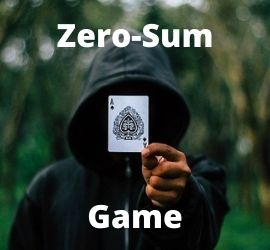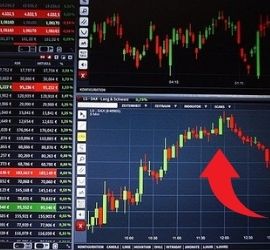What Is a Zero-Sum Game?
 In a zero-sum game, one person’s gain causes another person to lose an equal amount. For everyone involved, the net change is zero.
In a zero-sum game, one person’s gain causes another person to lose an equal amount. For everyone involved, the net change is zero.
The stock market, in the long run, is not a zero-sum game. There is real and actual wealth creation from economic growth in the stock market.
A zero-sum game is a situation in game theory in which one person’s gain results in a corresponding loss to another participant. The resulting net change in wealth or benefit is zero. A zero-sum game may have as few as two players or as many as millions of participants.
Zero-Sum Game – A Closer Look
Zero-sum games are found in game theory but are less common than non-zero-sum games. For example, poker and gambling are popular examples of zero-sum games. This occurs when the sum of the amounts won by some players equals the combined losses of the others. Games like chess, tennis, and badminton are also zero-sum games where there is one winner and one loser. Zero-sum games are the opposite of win-win situations. For example, a trade agreement that significantly increases trade between two nations. Zero-sum is also different from a lose-lose situation, like war, for instance. However, things are not always so obvious in real life. Gains and losses are often difficult to quantify.
What is a Non-Zero Sum Game?
An example can be found in a normal business environment within an expanding economy. Competing firms promote and advertise to expand the overall size of their market. Creating industry-wide expansion increases confidence in the industry and results in more profit for all competitors. Non-zero-sum games don’t have to create a net positive result. The outcome can also be negative as well. For example, a deep recession can result in negative growth and severely restricted market activity.
- Positive-sum game – is a term that refers to situations in which the total of gains and losses is greater than zero. A positive-sum occurs when resources are somehow increased and an approach is formulated in which the desires and needs of all concerned are satisfied. One example would be when two parties both gain financially by participating in a contest, no matter who wins or loses. Positive-sum outcomes occur in instances of distributive bargaining where different interests are negotiated so that everyone’s needs are met.
- Zero-sum game – The term zero-sum game refers to situations in which the total of wins and losses adds up to zero, and thus one party benefits at the direct expense of another.
- Negative-sum game – The term negative-sum game describes situations in which the total of gains and losses is less than zero, and the only way for one party to maintain the status quo is to take something from another party. It is in the context of negative-sum games that the most serious competition tends to occur.
Example: Non-zero-sum game
A non-zero-sum game is a situation where there is a net benefit or net loss to the system based on the game’s outcome. An example of what should be considered a non-zero-sum game is a contest between a trade ship and a pirate ship, although it may look like one at first glance. Here, a victory for the pirates would mean gains of wealth, resources, and men (probably as prisoners), whereas a win for the trade ship would only mean a defeat of the challenge by the pirates. Here, the prize and losses being different for both the contesting parties do not qualify it as an example of a zero-sum game. (Source: corporatefinanceinstitute)
Is the Stock Market a Zero-Sum Game?
The stock market is most often confused with a multi-player zero-sum game as there are numerous players in the market. Further, it is assumed that what some investors will lose is what other investors will gain. But this is not the case. The stock market, in the long run, is not a zero-sum game. There is real and actual wealth creation from economic growth in the stock market.
At first glance, stock trading appears to closely resemble a zero-sum game. With any stock trade, one side wins, when it buys a stock or security that increases in price. Conversely, when it sells a stock that declines, and the other side loses by the same amount. In aggregate, then, the stock market’s collective trades appear to amount to nothing at all. However, by definition, a zero-sum game is one in which no wealth is created or destroyed. So, in a two-player zero-sum game, whatever one player wins, the other loses. In a zero-sum game, gains for one person causes losses for another person in an identical amount. The net change for everyone involved is zero and no wealth is created or destroyed during the transaction.
Stock markets create wealth
In long run, the overall market value historically increases. As a result, the stock market is not a zero-sum game. A stock market is a place for investment in businesses. These businesses grow and expand and the increased output increases profitability. As a result, the future prospects of the businesses improve and the overall economy expands. This translates to an increase in the valuation of the companies and businesses. Ultimately it results in actual value creation and wealth addition in the stock market.
When you buy a share of stock, you are actually acquiring a percentage of equity in that company. As the business grows, it increases in value due to that growth. This translates into actual wealth creation in the overall stock market. Investors, in the long run, gain more through increased valuation and wealth creation.
Is Day Trading a Zero-Sum Game?
The increase in the stock market overall is an increase in value and wealth. It is completely unrelated to daily trading losses. Therefore, over time, trading gains outweigh trading losses for investors as a group. Individual investors may realize losses, but the overall market steadily gains in added value and new wealth.
If the only way to make gains in the stock market is for someone else to take a loss, then the stock market would never be able to go up in value. To view it as a zero-sum game, you have to ignore the stocks themselves. Then each transaction is a payment or loss for one party and a receipt or gain for the other. However, the stocks themselves do have greater potential value above what investors pay for them. The net present value of future payments has an intrinsic worth.
Of course, there is risk involved and some stocks will turn out to be worthless. But, on average the gains outweigh the losses from a historical perspective. Unlike the options and futures markets, the stock market is not a zero-sum game. When the economy grows and company profits grow, it ultimately leads to growing stock prices. Historically, the stock market has more winners than losers over the long run.
Options and futures trading
Options and futures trading is the closest practical example to a zero-sum game scenario. This is because contracts are agreements between two parties. If one person loses, then the other party gains. Consider a very simplified example of options and futures. Generally, if the price of the commodity or underlying asset rises within a set time frame, an investor can close the futures contract at a profit. Therefore, if an investor makes money from that bet, there will be a corresponding loss. The net result is a transfer of wealth from one investor to another and a zero-sum result.
Zero-Sum Game vs. Game Theory
Game theory is a mathematical field with wide and diverse applications. It can be used to decide the best approach in competitions of various kinds. When trying to apply it to real-world situations, special attention should be paid to the nature of the game. A zero-sum game, for instance, requires fixed resources and a closed system. Game theory, combined with computer science, provides a systematic, quantitative approach to choosing the best strategy in competitive situations. This strategy provides a powerful decision-making tool in many contexts, including investing and even management. However, the game theory also has limitations, especially if the competition has many contestants. Game theory provides general rules for rational decision-making, but it doesn’t necessarily lead to winning strategies.
Because a zero-sum game involves one person’s gain and another’s loss, the net change or overall benefit to the group is zero. This type of game can have any number of players as long as it has at least two. To be a truly zero-sum game, the total value of losses has to exactly equal the total value of gains For zero-sum games, we assume that none of the players knows the strategy of the other players and that their decisions are rational.
Game theory and finance
The conventional approach to business is to portray it as a zero-sum game. That means that any advantage gained by a rival represents a loss for your company. But following such an approach causes companies to actively attempt to impede their competitors’ successes. This zero-sum view can foster damaging negative consequences. For example, monopolistic behavior, price and format wars, a lack of compatibility in products, and risks to sustainability. In reality, it’s not necessarily true that a rivals’ profits directly determine your losses. Even if you believe that global resources are limited, there are always opportunities to discover new ways of utilizing resources more efficiently. There is also the incentive to find innovative substitutes or new ideas about how to deploy those resources.
Game theory in finance explores decision-making in a world that is uncertain, has limited resources, and is less than transparent. This is particularly important when it comes to predicting what is going through the minds of other players. The notion of a “game” suggests there’s a degree of competition taking place, often over those limited resources. The value of a game theory is to understand the human component. To quantify as far as possible the various outcomes of actions or strategies. Game theory is not about providing absolute answers but about gaining insights into how the actions of one player or multiple players affect each other.
One of the key assumptions of game theory is that players are rational. However, this assumption of rationality doesn’t rule out the possibility that another player may mistakenly prefer some strategies over others. In determining their preferences and selecting their options, players can take into account available information, probabilities, and potential costs and benefits. As in markets, players are rational if they have a clear view of their goals.
Zero-Sum Game Examples
When applied specifically to economics, there are multiple factors to consider when understanding a zero-sum game. A zero-sum game assumes a version of perfect competition and perfect information. Opponents in the model have all the relevant information to make an informed decision.
A good example to see how zero-sum games can be used to model real-world situations is a simple election. However, even this simple example fails to account for all complexities. Consider three candidates where each receives some number of votes and the candidate with the highest number of votes wins. This situation is often described as a zero-sum game. If one candidate wishes to gain more votes, they must be taken from the other candidates. However, this is only true under the assumption that every single person in the population is voting for one of the three candidates.
What if some voters are abstaining? This allows for a candidate to increase his vote total by attracting abstaining voters, without decreasing any of the other candidate’s totals. We may know how many people are eligible to vote, but we can never know in advance the exact number who will actually cast ballots. It can happen that a candidate will gain votes in a second electoral round without his or her opponent necessarily losing votes. This is because new voters appeared who did not participate in the first round.
Other common real-life examples of zero-sum games include games like chess, badminton, and tennis. Baccarat, blackjack, poker, and roulette are popular zero-sum gambling games. In each of these cases, a win for one player results in a loss for the other. In gambling games, an increase in one player’s payoff corresponds to a decrease in another player’s payoff.
Up Next: What Do Three White Soldiers Mean?
 The Three White Soldiers is a bullish candlestick formation on a stock trading chart signaling a bullish reversal at the end of a downtrend.
The Three White Soldiers is a bullish candlestick formation on a stock trading chart signaling a bullish reversal at the end of a downtrend.
The three white soldiers formation is used by analysts and traders to predict the reversal of the current downtrend in a stock pricing chart. The pattern consists of three consecutive long-bodied candlesticks that open within the previous candle’s body. Each close exceeds the previous candle’s high. Ideally, these candlesticks should not have very long shadows or wicks. Also, they should open within the real body of the preceding candle in the formation.




